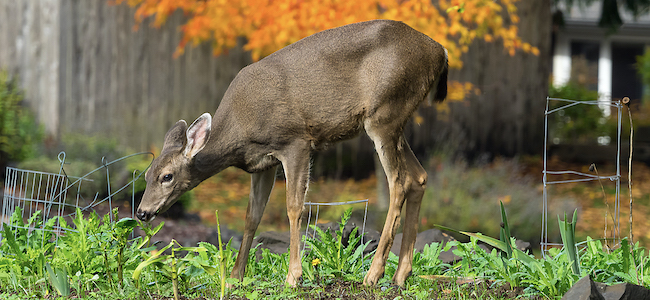
If you put time and effort into maintaining your lawn, the last thing you want is for it to turn into a playground for local critters. If raccoons, skunks, rabbits, squirrels, or stray cats are using your lawn and leaving behind a big mess, there are steps you can take to make your lawn less appealing so they move elsewhere. Here are some strategies for keeping animals out of your yard.
6 Ways to Keep the Animals Off Your Lawn
Fencing is the most common and effective way to deter animals away from your yard. Fencing can help to keep both large and small animals out of your grass, provided you choose the right materials and set the posts at the right height and width. If you need to restrict only part of your yard, say a garden, chicken wire can be an effective and affordable solution.
Many small animals seek out dens in the late fall and winter, so be sure to block access to areas under decks and porches. Chicken wire and lattice are good options, but be sure to choose materials with small openings, as stray cats, raccoons and skunks can fit through surprisingly small holes.
You can purchase non-toxic commercial repellants for the type of animals using your yard. These are mostly made of a mix of plant-based chemicals that irritate an animal’s nasal passages, and will likely irritate human nasal passages, too. Follow the directions carefully, and keep pets and small children away from treated areas.
A homemade remedy is to use cayenne pepper, which contains capsaicin, a primary ingredient in bear sprays. To apply, sprinkle cayenne pepper in areas nuisance animals frequent. You can also make a solution of water and cayenne and spray shrubs and plants to prevent them from being eaten. Capsaicin has dual benefits: It also it also acts as a natural insecticide against grass destroying grubs. Again, keep pets and kids off treated areas.
Most animals strongly dislike the smell of white vinegar. To use, put vinegar in a bottle and spray the perimeter of your lawn as if you’re creating an invisible fence. You must be careful however because vinegar has the potential to destroy and damage most plants so keep it away from any that are nearby.
Mothballs are another scent animals dislike; the drawback to using them is that most people dislike the smell, too. You probably won’t want to use them right around your deck, but if you have animals causing damage in areas far from the house, mothballs may be a good choice.
Scare devices are an easy and harmless way of frightening animals away from your lawn. Some examples of common scare devices include noisemakers, motion-activated sprinklers, pinwheels, and items that mimic the shape of predators.
Trapping
You may be tempted to start out by trapping the animals making a mess of your lawn, but ideally, you’ll want to try and change the conditions that are attracting the animals first. If none of these solutions have worked, you can trap the animal and release it in a park or forested area. You can also contact a specialist to do the trapping for you.
One final tip: Raccoons, skunks, opossums and stray cats are scavengers, so don’t accidentally provide food. Be sure to clean grills and outdoor tables after using, keep garbage cans tightly closed and bring pet food bowls inside in the evenings. Once their food supply dries up, they’ll likely move on.
Need additional tips on how to keep unwanted animals off your lawn, or out of your garden and trash? Watch Exmark’s Original Done-In-A-Weekend episode, “How to Keep Unwanted Animals off Your Lawn.”
SHARE





